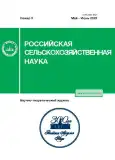Diversity and pathogenicity of the Fusarium fungi occurred in soybean mycobiota
- Авторлар: Gavrilova O.P1, Orina A.S1, Gagkaeva T.Y.1
-
Мекемелер:
- All-Russian Institute of Plant Protection
- Шығарылым: № 3 (2023)
- Беттер: 31-35
- Бөлім: Articles
- URL: https://journals.rcsi.science/2500-2627/article/view/144614
- DOI: https://doi.org/10.31857/S2500262723030067
- EDN: https://elibrary.ru/EZAODK
- ID: 144614
Дәйексөз келтіру
Толық мәтін
Аннотация
Негізгі сөздер
Авторлар туралы
O. Gavrilova
All-Russian Institute of Plant Protection196608, Sankt-Petersburg, sh. Podbelskogo, 3
A. Orina
All-Russian Institute of Plant Protection196608, Sankt-Petersburg, sh. Podbelskogo, 3
T. Gagkaeva
All-Russian Institute of Plant Protection
Email: t.gagkaeva@mail.ru
196608, Sankt-Petersburg, sh. Podbelskogo, 3
Әдебиет тізімі
- Экспертно-аналитический центр агробизнеса. URL: https://ab-centre.ru/news/soya-ploschadi- sbory-i-urozhaynost-v-2001-2019-gg (дата обращения: 02.11.2022).
- Characterization and pathogenicity of Fusarium species associated with soybean pods in maize/soybean strip intercropping / M. Naeem, H. Li, L. Yan, et al. // Pathogens. 2019. Vol. 8. Article. 245. URL: https://www.mdpi.com/2076-0817/8/4/245 (дата обращения: 22.03.2023).
- Characterization of species of Fusarium causing root rot of Soybean (Glycine max L.) in South Dakota, USA / P. N. Okello, K. Petrovic, A. K. Singh, et al. // Canadian Journal of Plant Pathology. 2020. Vol. 42. P. 560-571.
- Evaluation of pathogenic Fusarium spp. associated with soybean seed (Glycine max) in Hubei province, China / L. Zhao, X. Wei, T. Zheng, et al. // Plant Disease. 2022. Vol. 106. P. 3178-3186.
- Genetic diversity and aggressiveness of Fusarium species isolated from soybean in Alberta, Canada / Q. Zhou, N. Li, Chang K.-F., et al.// Crop Protection. 2018. Vol. 105. P. 49-58.
- Действие фунгицидов на рост патогенов сои из рода Fusarium / А. С. Орина, Н. П. Шипилова, Е. Л. Гасич и др. // Защита и карантин растений. 2019. № 3. С. 17-19.
- Leslie J. F., Summerell B. A. The Fusarium Laboratory Manual. Blackwell Publishing: Ames, IA, USA, 2006. 388 p.
- Multiple evolutionary origins of the fungus causing Panama disease of banana: concordant evidence from nuclear and mitochondrial gene genealogies / K. O'Donnell, H. C. Kistler, E. Cigelnik, et al. // PNAS. 1998. Vol. 95. P. 2044-2049.
- DNA sequence-based identi cation of Fusarium: a work in progress / K. O'Donnell, B. K. Whitaker, I. Laraba, et al. // Plant Disease. 2022. Vol. 106. P. 1597-1609.
- Natural deoxynivalenol occurrence and genotype and chemotype determination of a field population of the Fusarium graminearum complex associated with soybean in Argentina / G. Barros, M. S. Alaniz Zanon, A. Abod, et al. // Food Additives and Contaminants: Part A. 2012. Vol. 29. P. 293-303.
- Diaz Arias M. M., Leandro L. F., Munkvold G. P. Aggressiveness of Fusarium species and impact of root infection on growth and yield of soybeans // Phytopathology. 2013. Vol. 103. P. 822-832.
- Identification of Fusarium species associated with soybean root rot in Sichuan Province, China / X. Chang, H. Dai, D. Wang, et al. // European Journal of Plant Pathology. 2018. Vol. 151. P. 563-577.
- One Fungus, One Name: De ning the genus Fusarium in a scienti cally robust way that preserves longstanding use / D. M. Geiser, T. Aoki, Ch. W. Bacon, et al. // Phytopathology. 2013. Vol. 103. P. 400-408.
- Fusarium commune is a new species identified by morphological and molecular phylogenetic data / K. Skovgaard, S. Rosendahl, K. O'Donnell, et al. // Mycologia. 2003. Vol. 95. P. 630-636.
- Phylogenetic analysis and molecular typing of trichothecene-producing Fusarium fungi from Russian collections / A. A. Stakheev, L. V. Samokhvalova, O. D. Mikityuk, et al. // Acta Naturae. 2018. Vol. 10. No. 2. P. 79-92.
- Грибы рода Fusarium на клубнях картофеля / А. Ф. Белосохов, М. М. Ярмеева, А. М. Долгов и др. // Современная микология в России. 2022. Т. 9. С. 250-252.
- First report of Fusarium commune causing root rot of soybean seedlings in Indiana / C. Detranaltes, M. Saldanha, S. Scofield, et al. // Plant Disease. 2022. Vol. 106. Article 3216. URL: https://apsjournals.apsnet.org/doi/10.1094/PDIS-04-22-0870-PDN (дата обращения: 22.03.2023).
- Choi H.-W., Kim S., Hong S. K. Diversity and pathogenic characteristics of Fusarium species isolated from wilted soybeans in Korea // The Korean Journal of Mycology. 2020. Vol. 48. P. 297-312.
- First report of Fusarium proliferatum causing root rot in soybean (Glycine max L.) in Canada / K. F. Chang, S. F. Hwang, R. L. Conner, et al. // Crop Protection. 2015. Vol. 67. P. 52-58.
- Early physiological responses of Arabidopsis thaliana cells to fusaric acid: toxic and signaling effects / B. Bouizgarne, H. El- Maarouf- Bouteau, C. Frankart, et al. // New Phytologist. 2006. Vol. 169. P. 209-218.
- Hartman G. L., Huang Y. H., Li S. Phytotoxicity of Fusarium solani culture filtrates from soybeans and other hosts assayed by stem cuttings // Australasian Plant Pathology. 2004. Vol. 33. P. 9-15.
- Identification of multiple phytotoxins produced by Fusarium virguliforme including a phytotoxic effector (FvNIS1) associated with sudden death syndrome foliar symptoms / H. X. Chang, L. L. Domier, O. Radwan, et al. // Molecular Plant- Microbe Interactions. 2016. Vol. 29. No. 2. P. 96-108.
- Hartman G. L., Chang H.-X., Leandro L. F. Research advances and management of soybean sudden death syndrome //Crop Protection. 2015. Vol. 73. P. 60-66.
Қосымша файлдар









